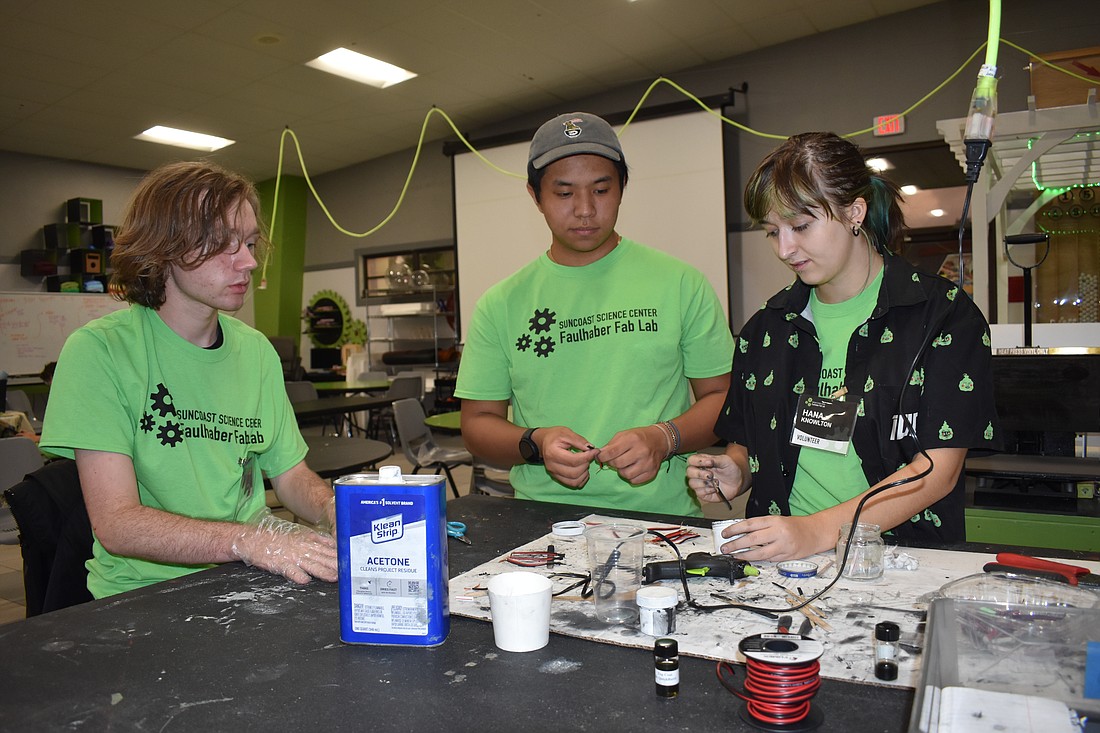- July 26, 2024
-
-
Loading

Loading

Age isn’t the most important factor when it comes to reaching great heights in The Team True Fire Rocketry Club.
Although the team is labeled as a high school group, a sixth grader, Miles Cuff, was accepted on board as a safety manager.
“I was really interested in it when I heard about it, so I wanted to do it,” said Cuff, who has been involved in making his own rockets at home.
Russell Finger, the team’s mentor and a Suncoast Polytechnical High School teacher, said what sets the rocketry club apart is that it is student directed.
“I’m here to provide support as far as safety, but they determine what their goals are, what they’re going to do at any given time, and work together to develop a plan for moving forward,” he said.
The team of nearly 20 local middle and high school students comes together each week to experiment with fuel, perform research, fabricate components, program electrical components, and work on the needed certifications for their next launch in Spring 2024.
This year, they have an ambitious goal — to launch the rocket 10,000 feet, exceeding the previous 6,400 — but Daniel Desear, the 11th grader who is leading the team this year, said he is sure they are on track to succeed.
“I do have a feeling it’s going to go pretty high, and I'm not worried about hitting that goal at all. I'm more worried about the ceiling that we might might hit,” he said, noting that the maximum allowed height is 14,900 feet.
Increasing the height is not possible without switching up the engineering process.
Enhancements to last year’s strategy are being implemented, including experimentation with a new fuel formula to increase the rocket’s propulsion.
The formula, which uses a solid state propellant, or a solid mass packed into a cylinder, offers greater thrust and efficiency, said Desear.
It was provided by Sebastian Grabowski, who founded the team in 2022 and is currently pursuing a degree in Aerospace Engineering at the University of Colorado Boulder.
The mixing process itself is seeing improvements as well; this year, the students have created a fume hood, or ventilated enclosure, in an old kitchen in the lab.

Separated from the rest of the lab with curtains, the area keeps materials like the more volatile organic components, and aluminum dust, away from the rest of the lab.
Additionally, a full fuel team has now been assembled, while last year, 10th grader Tristan Linander, had mixed the fuel himself.
“Compared to last year, it’s a lot faster,” he said.
Eleventh grader Austin Bruce is assembling the rocket from a kit that cost about $600. It will stand about 12 feet tall, slightly taller than last year’s, and is secured with high-grade rocket epoxy, allowing it to withstand extremely high temperatures.
This year, the team has chosen three fins instead of four, which Bruce said decreases stability but increases altitude.
“We are going for more of that altitude, and taking a little bit of that extra risk,” he said.
Meanwhile, the ignition team creates the component that will start the rocket.
The ignition involves wires, placed about 1/16th of an inch apart and coated with a mixture that includes carbon and acetone, which are glued to the inside of a straw with chemical powders added, and closed off with cotton.
“The main challenge is tuning fine motor skills to make the igniters that are consistently working,” said 12th grader Hana Knowlton. “Because it's such a small and intricate process, if one thing goes wrong, then the entire igniter is not going to work.”
An electronics squad helps provide components for the rocket.
On the evening of Nov. 15, they were assembling an altimeter, which senses the altitude of the rocket and controls when the parachute deploys.
“Typically, they would come all together already soldered, but that includes about $250 worth of cost, so we decided we’re up for the job,” said Desear.
The team's regular responsibilities include working with the load cell, which tests the strength of different motors, and creating programs to analyze the data.
Finally, Cuff serves as the safety manager, and his responsibilities have included creating the documents which list the chemicals and ingredients involved and information on their hazards, proper usage, and storage.
However, there is more work to be done besides the creation of the rocket itself.
Twelfth grader Sara Bravo manages the team’s social media, student-designed website, and GoFundMe page, posting updates each week to help attract more donors, using photographs she has taken.
“I was really interested in rocketry, but I wasn’t wanting to pursue anything in the aerospace field, so I saw social media as an opportunity to still be a part of something really cool,” she said.

Students said the program offers a unique chance to experience an aspect of the engineering field in a way they can in few other places.
“There aren't really any high school rocketry teams, not even nationally,” said Knowlton. “So, I think this is a really good resource for kids to explore their interests, especially in aerospace, since it's a pretty specific field, and it's good for people to be able to dip their toes in before committing to a college degree.”